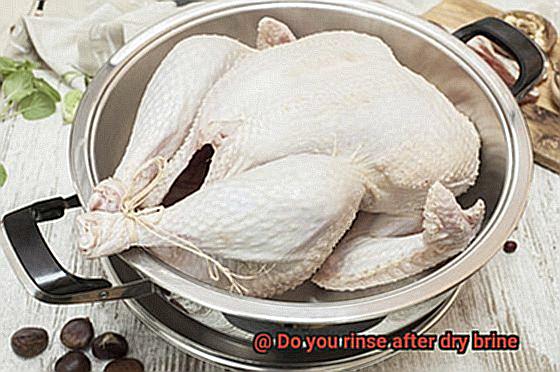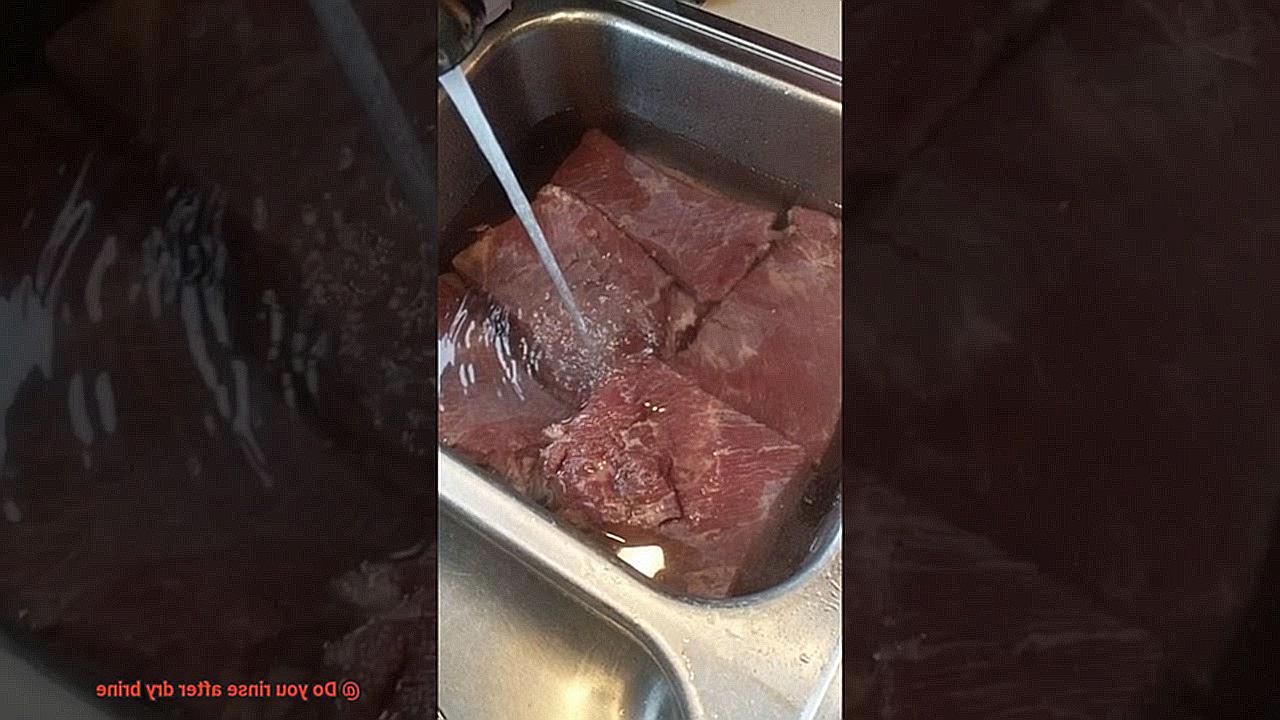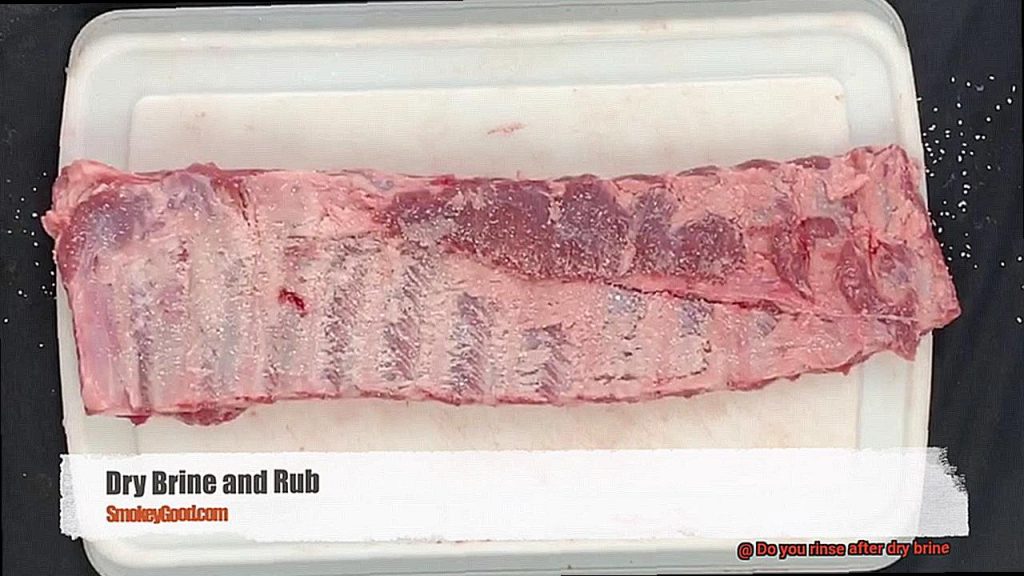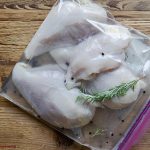Imagine this: You’ve just finished dry brining your turkey for Thanksgiving dinner, following a recipe that your friend swore by.
The directions say to let the bird sit in the fridge for a few hours before cooking it as usual. But as you’re about to pop it into the oven, a nagging question pops up in your mind – do you rinse after dry brine?
This is a conundrum that has left many home cooks scratching their heads, and for good reason. On one hand, rinsing off excess salt can prevent the meat from becoming too salty.
However, rinsing can also wash away some of the flavors that the dry brine has imparted to the meat. In this blog post, we will take a deep dive into whether or not to rinse after dry brine.
We’ll examine both sides of the argument and weigh up the pros and cons of rinsing. We’ll also debunk some myths surrounding this question and find out if there’s any truth to them.
So, get ready to become a pro at dry brining.
Contents
What is Dry Brining?
If you are looking for a way to enhance the flavor and texture of your meat, dry brining is a technique worth trying. Unlike wet brining, which involves soaking meat in a saltwater solution, dry brining involves rubbing the meat with a mixture of salt, sugar, and other seasonings and letting it sit uncovered in the refrigerator for several hours or overnight. Here are some key things to keep in mind when dry brining your meat:
- Dry brining is particularly effective for thicker cuts of meat like roasts, steaks, and chops. When you apply the mixture of salt and other seasonings to the surface of the meat, the salt draws moisture out of it, which is then reabsorbed along with the seasonings. This results in a more evenly seasoned and juicier end product.
- Dry brining creates a crispy, flavorful crust on the surface of the meat when cooked. The dry surface allows for better browning and caramelization during cooking, which enhances the flavor and texture of the meat.
- Another benefit of dry brining is that it can help to tenderize tougher cuts of meat. It does this by breaking down proteins and increasing moisture retention.
- When it comes to rinsing off the salt before cooking, there are differing opinions. Some recipes call for rinsing to remove excess salt, but this can also wash away some of the seasonings and flavors that have been absorbed into the meat. Others recommend not rinsing to retain all of the flavors and seasonings.
- It’s important not to over-salt your meat when dry brining. This can make it too salty if you use too much salt or let it sit for too long. Experiment with different amounts of salt and seasonings to find what works best for your taste buds.
Benefits of Dry Brining
Dry brining is the technique for you. As an expert on the benefits of dry brining, I can attest that this simple technique can transform your meat into a succulent and flavorful masterpiece. Let’s explore some of the many benefits of dry brining.

Firstly, dry brining locks in moisture, resulting in juicier and more flavorful meat. By salting the meat and letting it sit for several hours or even days in the refrigerator, the salt penetrates the meat and breaks down its proteins. This process not only seasons the meat but also tenderizes it, making it more succulent and delicious. Plus, the salt draws out any excess moisture from the meat, creating a brine that is slowly reabsorbed into the meat.
Secondly, dry brining creates a more evenly cooked piece of meat. The salt helps to break down the muscle fibers, making them more relaxed and pliable. This allows heat to penetrate more evenly throughout the meat, ensuring that it cooks evenly from top to bottom. You’ll never have to worry about unevenly cooked meat again.

Moreover, dry brining can help reduce cooking time. It pre-salts the meat, allowing it to cook faster and more efficiently. This means that you can achieve a perfectly cooked piece of meat without spending as much time on the grill or in the oven.
Finally, dry brining is a simple and easy technique that requires minimal effort. Unlike wet brining, which can be messy and time-consuming, dry brining only requires a few basic ingredients and a little bit of patience. It’s an excellent way to take your grilling game to the next level without investing in expensive equipment or spending hours in the kitchen.
Should You Rinse After Dry Brine?
Then it’s time to try dry brining. This technique involves rubbing salt and other seasonings onto the surface of meat and letting it sit in the refrigerator for several hours or overnight. The result is a juicy, flavorful piece of meat that cooks evenly and in less time. But the big question is: should you rinse after dry brining?
The answer is not black and white. Some experts argue that rinsing after dry brining can remove some of the flavor created by the dry brine. Others believe that rinsing removes excess salt from the meat. So what’s the verdict?
When it comes to poultry, it is generally recommended to rinse after dry brining to remove any excess salt. Poultry tends to be more sensitive to salt than other meats, so rinsing can help prevent it from becoming too salty. However, be aware that rinsing can also remove some of the flavor created by the dry brine. If you choose to rinse, be sure to pat the meat dry with paper towels before cooking.
But when it comes to beef and pork, rinsing after dry brining is not necessary. In fact, many chefs argue that rinsing can actually diminish the flavor created by the dry brine. Instead, simply patting the meat dry with paper towels before cooking is sufficient.

Ultimately, whether or not to rinse after dry brining is a matter of personal preference. It depends on how much salt you used in your dry brine and how sensitive your meat is to salt. If you’re unsure, try a small test batch and see if you prefer the taste with or without rinsing.
Pros and Cons of Rinsing After Dry Brine
The answer is not straightforward as there are pros and cons to both approaches.
Let’s start with the benefits of rinsing after dry brining. One of the most significant advantages is that it reduces excess salt.
When you apply a salt and seasoning mixture to the meat’s surface, it draws out moisture and infuses it with flavor, but it can also leave behind too much salt. Rinsing your meat after dry brining removes any excess salt, which helps achieve a well-balanced flavor.
However, opponents argue that rinsing can also wash away some of the flavorful seasoning mixture. This can be especially true for dry rubs that contain a variety of spices and herbs in addition to salt.
In this case, experts recommend patting the meat dry with a paper towel instead of rinsing to maintain as much flavor as possible.
Moreover, rinsing may not always be necessary. For instance, if you’re using a small amount of salt in your dry brine, there may not be any excess to remove. Similarly, if you’re using a seasoning mixture with other flavorful ingredients, rinsing may not be ideal as you could end up washing away some of the flavors.
Preparing the Meat for Dry Brining
Preparing meat for dry brining may seem intimidating, but it’s actually a simple process that can elevate your dish to new heights. To start, it’s important to trim any excess fat or silver skin from the meat before applying the dry brine. This not only enhances the appearance of the meat, but also ensures that the dry brine can penetrate and season every inch of it.
Once you’ve trimmed your meat, take a moment to pat it dry with a paper towel. This step is crucial since moisture on the surface of the meat can prevent the dry brine from sticking properly. We want every bit of the seasoning mixture to cling to the meat for maximum flavor.
Next, generously apply the dry brine mixture to all sides of your meat and rub it in thoroughly. A good rule of thumb is to use approximately 1 tablespoon of dry brine per pound of meat, but feel free to adjust based on personal preference.
After applying the dry brine, let your meat rest in the refrigerator for at least 12 hours (but no more than 24 hours). During this resting period, the salt in the dry brine will work its way into the meat, infusing it with mouthwatering flavor while also breaking down proteins for a tender and juicy end result.
Now, onto the question of whether to rinse off the dry brine before cooking. The answer is a resounding no. Rinsing would wash away all that delicious flavor we worked so hard to achieve and could also make searing and browning more difficult due to excess moisture on the surface of the meat. Instead, simply pat your meat dry with a paper towel before cooking and savor every bite of your perfectly seasoned creation.
How Long Should You Leave the Meat in the Refrigerator?
Timing is key. Dry brining involves applying salt to the surface of the meat and allowing it to sit in the refrigerator for a period of time before cooking. But how long should you leave the meat in the refrigerator for optimal results?
In general, it’s recommended to refrigerate the meat for at least 12-24 hours after applying the dry brine. During this time, the salt will penetrate into the meat and begin to break down its fibers, resulting in tender and flavorful meat. However, keep in mind that certain types of meat may require longer or shorter periods of time depending on their size and thickness.
For larger cuts of meat like roasts or whole chickens, it’s best to leave them in the fridge for up to 48 hours to allow the salt to fully penetrate and infuse delicious flavors throughout. Thinner cuts like steaks or pork chops may only need 6-8 hours in the refrigerator.
But beware – leaving your meat in the refrigerator for too long can have negative effects on its texture and flavor. Over-brining can result in mushy meat and an overly salty taste. So be sure to follow guidelines for specific cuts of meat and not exceed recommended brining times.
Tips for Successful Dry Brining
Dry brining is a culinary technique that can take your meat game to the next level. It involves rubbing salt and other seasonings onto the meat and letting it sit in the fridge for several hours or overnight. While dry brining may seem simple, there are some tips you should keep in mind to ensure that your dry brine is successful. Here are five sub-sections that will help you master the art of dry brining:
Use the Correct Amount of Salt:
When it comes to dry brining, the amount of salt you use is crucial. Using too much salt will result in an overly salty dish, while too little will leave your meat under-seasoned and bland. As a general rule, use about 1 teaspoon of kosher salt per pound of meat.
Let the Meat Sit Uncovered in the Fridge:
Allowing the meat to sit uncovered in the fridge is essential for a successful dry brine. This step allows the meat’s surface to dry out, resulting in a crispy crust when grilled. It also allows the salt and seasonings to penetrate deeper into the meat, resulting in more flavorful and tender meat.
Cover the Meat Well:
When dry brining, make sure that you cover the meat or poultry well with plastic wrap or aluminum foil. This prevents any air from getting in and drying out the meat.
Pat the Meat Dry:
After removing the meat from the fridge, make sure to pat it dry with paper towels before cooking it. This ensures that any excess moisture is removed, allowing for a crispy crust when cooking.
To Rinse or Not to Rinse:
There is some debate about whether to rinse after dry brining or not. Some say that rinsing the meat after dry brining removes excess salt and seasoning, while others argue that it washes away some of the flavor that has developed during the dry brining process.
If you do decide to rinse, be sure to pat the meat dry before cooking it. If you choose not to rinse, be mindful of how much salt and seasoning you use in your dry brine.
Recipes to Try with Dry Brined Meats
If you’re looking for a way to add flavor and moisture to your meat, then this technique is for you. Dry brining involves rubbing salt and other spices onto your meat, letting it sit in the fridge for a period of time, and then cooking it to perfection. It’s a simple process that can take your meat from ordinary to extraordinary.
Dry brining works well with almost any type of meat, making it a versatile technique that can enhance the flavor and texture of your favorite cuts. Here are some mouth-watering recipes to try with dry brined meats:
- Dry Brined Grilled Chicken: For this recipe, start by dry brining bone-in chicken pieces for at least 2 hours (or up to 24 hours) in the fridge. Then, grill the chicken over medium-high heat until cooked through. The result will be juicy, flavorful chicken that is perfect for any occasion.
- Dry Brined Pork Chops: To make this recipe, dry brine thick-cut pork chops for at least 4 hours (or up to 24 hours) in the fridge. Then, sear them in a hot skillet and finish them off in the oven until they reach an internal temperature of 145°F. The result will be tender, flavorful pork chops that are sure to impress.
- Dry Brined Beef Roast: If you are looking for a show-stopping main course, try dry brining a beef roast before roasting it in the oven. Start by dry brining the roast for at least 24 hours in the fridge. Then, sear it in a hot skillet and transfer it to the oven to finish cooking until it reaches your desired level of doneness.
But these are just the tip of the iceberg. The possibilities are endless when it comes to dry brining meat. Here are some additional ideas to inspire you:
e1E1uVVBAdY” >
Conclusion
In conclusion, the debate over whether to rinse after dry brining is a complex one. Some argue that rinsing removes excess salt and prevents the meat from becoming overly salty, while others believe it can wash away the flavors and seasonings that have been absorbed into the meat. Ultimately, the decision to rinse or not depends on personal preference and how much salt was used in the dry brine.
Dry brining is a culinary technique that every home cook should try. It enhances flavor and texture, creates a crispy crust when cooked, tenderizes tougher cuts of meat, and reduces cooking time. To ensure success with dry brining, use the correct amount of salt, let the meat sit uncovered in the fridge for several hours or overnight, cover it well with plastic wrap or aluminum foil, pat it dry before cooking if rinsed, and experiment with different amounts of salt and seasonings to find your perfect balance.
From Dry Brined Grilled Chicken to Dry Brined Pork Chops, there are endless mouth-watering recipes to try with this versatile technique.






